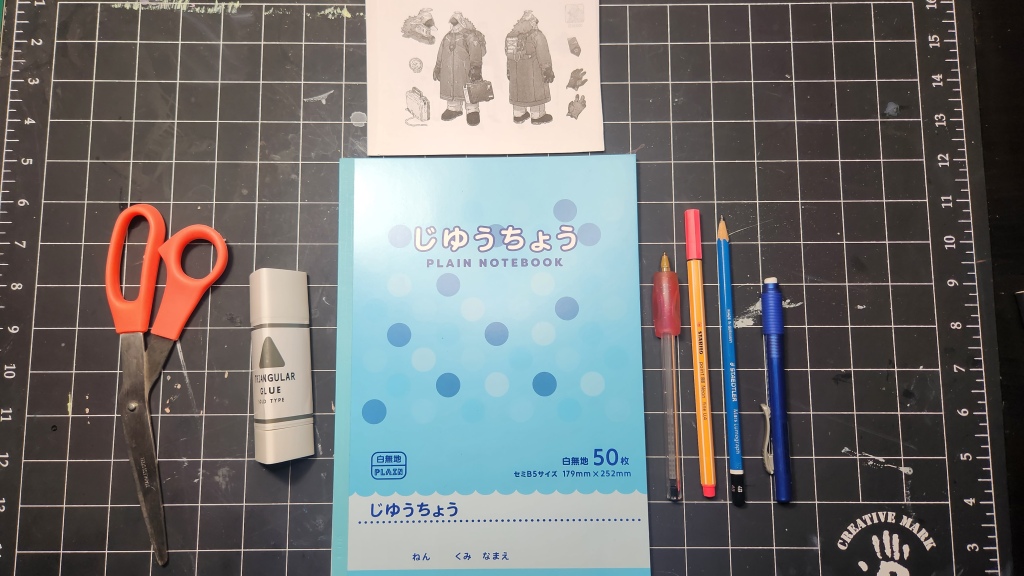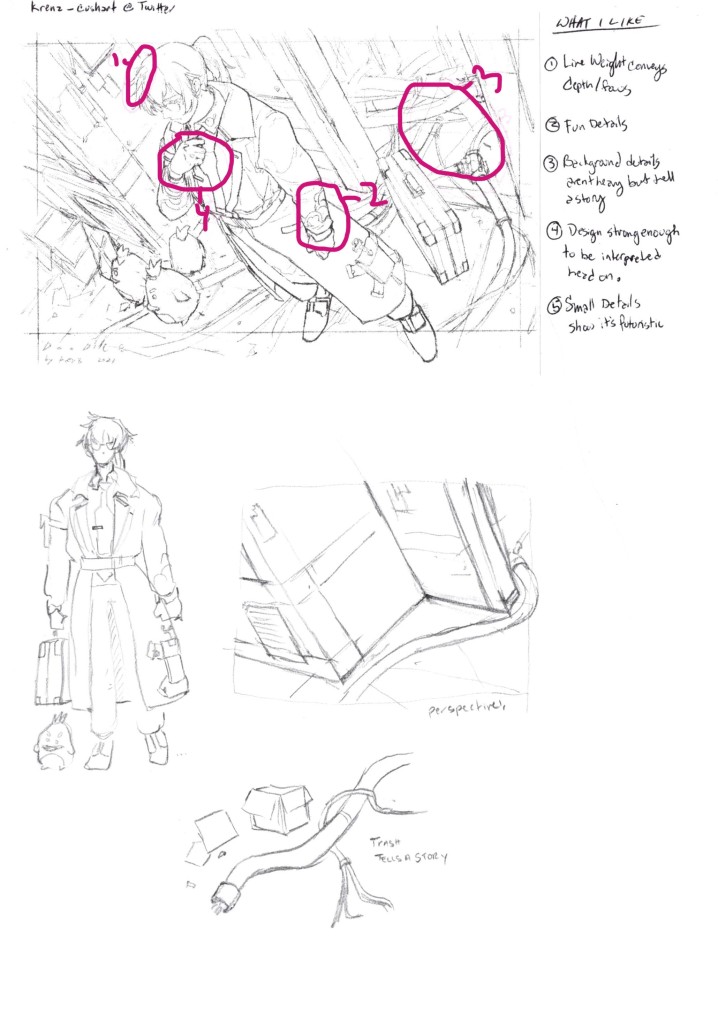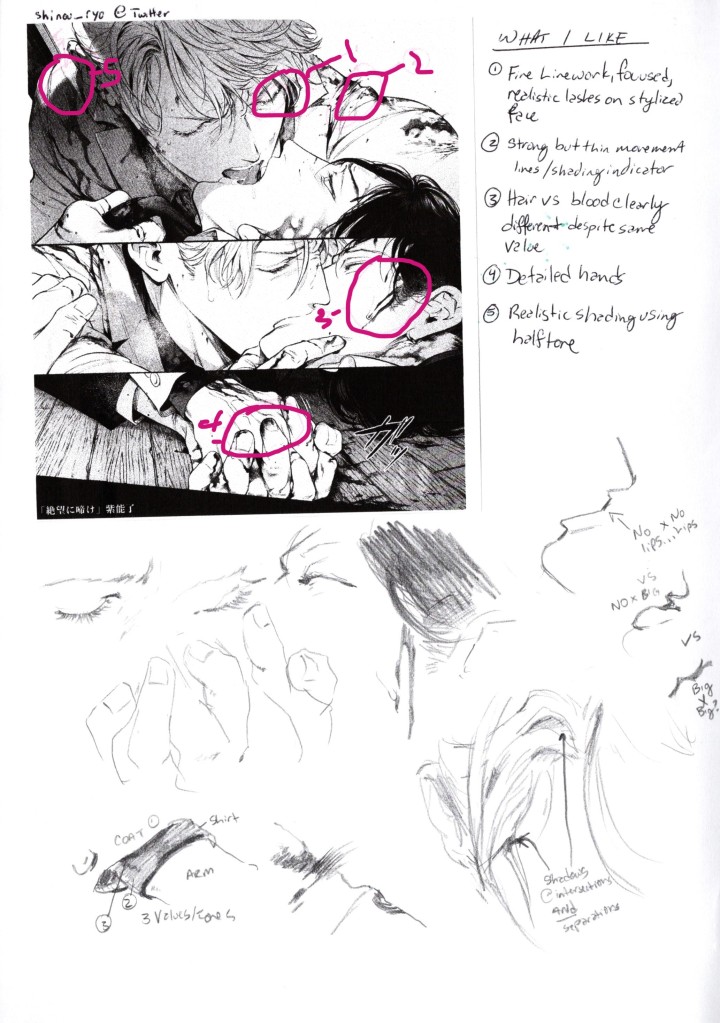There is one thing true about burnout for everyone and any type of burnout. There was once a time when you could do it. Before you burned out you could handle all of your various tasks. Before I burned out I could draw.
And in order to draw I had to learn how.
This sounds horribly trite now that I’ve typed it out but it’s the base of my point. When I first learned to draw back in high school-that’s right I’m not one of those drawing since I could hold a pencil sorts- I had one single reason to do so. I didn’t think my latest story would be best told in words, but rather as a manga (I was 16 and full weeb, sue me).
To reach that goal, I would arduously copy manga and anime that I loved while making changes I thought were cool. After mastering the secret art of the other and visible hands I felt confident enough to start translating things I saw into other angles or poses. After I’d done that for long enough I felt I could draw my own stuff. And I did!
I never lost the habit of marking images I really enjoy. Modern platforms make it easy with bookmark functions everywhere. But I did lose my habit of emulation.
Not the Starter, But the Fuel.
I stopped actively emulating styles when I was confident in my own style enough to work without a reference. I had a particular way of drawing chins, eyes, hair, and noses that suited me for the time. It made sense to stop the practice of emulating others because I was emulating myself.
After a while, the way I was drawing no longer suited my tastes. Tastes change, it’s a fact of life. Yet by the time my taste changed I no longer had a way to get out of it. The result? A circle of frustration that extended my burnout whenever I’d try to get back.
Without emulating artists I liked, I no longer knew what about their art I enjoyed. When I don’t know what I enjoyed, everything I tried sucked.
Finding Myself Again
It may not seem apparent yet, but I have a very fun life philosophy that many other artists and writers share: When in doubt, buy a notebook. I’ve got separate notebooks for tons of things. I was the kid in school who had a folder for each subject, and it stuck.
There’s potential to dive into each one and their purpose, but suffice to say I do actually use them. I have a journal, a commonplace, a thINKbook, specialty media sketchbooks, project notebooks, and a returning champion: The Inspo Book.

The Official F↑ book deserves its own post.
It’s a returning champion because my first sketchbooks were analogous to this. I no longer have them because these weren’t my sketches. They were just observations of what I liked at the time. Going back to that feels like going back to who I was when I first learned to draw.
It feels like it might work this time.
What It Is
Sketchbook might also be too lofty a word for the first version. They were piles of printer paper in cheap brad folders. Archival concerns were a non-issue. They got tossed into recycling with the rest of my class notes at the end of the year.
Now I’m a staunch supporter of perfect-bound notebooks, so the format has changed, but the heart is still the same. Cheap, high volume, disposable. I will be tossing this once it’s full.
I think that’s the most important part of this. It’s disposable. More than anything else this is a tool to be discarded. Keeping it and revering the notes you take would turn it into a style guide. This is also why I’d urge keeping this separate from your personal sketchbook, even if you’re a single-spot sort of person.
The second component is a set of images. Specifically stylized ones. Sculptures, paintings, drawings, animation frames all work. You’re not going to find style in a photo of real objects. Save that for the anatomy/perspective studies. I would also urge that even though this is not something you’ll be sharing online -it’s not your work, it’s an analysis of someone else’s-, you should do your best to find the original source.
Why? When you know who you admire you can see what they admire. Modern social media and the strength of search engines makes it very easy to go down a rabbit hole and find even more inspiration. It’s so much better than waiting on an interview like in ye-olden-days.
The final component is you! This is all about you and what you like, what made you look, the specific things that draw you to the image, the way your eye goes around it. If an entire classroom of people were given a set of identical images and told to do this project, no two would be the same.
How to Make an Inspo Book
The simplest way is to print out copies of illustrations with room on the paper for your notes. You’d want to limit it to one image per letter-sized paper, just for detail visibility. The digital method would be the same, though I do find the zoom capabilities make it easy to get lost in the weeds.
If you’re like me and don’t want to do anything the simple way, here’s what you’ll need:
Materials:

- Your images on cheap non-archival printer paper. I used grayscale because I’m not trying to analyze color this go-around. Since it’s B5 I put 4 images per page in A4, this is just large enough to be clear but not detailed. If you want a high res picture, buy it from the artist.
- A CHEAP notebook with the size and lining of your preference. I picked this up at DAISO because it’s the closest dollar store to me. Remember, we’re throwing this away in a few weeks.
- Scissors to cut out images
- Glue, something compatible with the super thin cheap paper (liquid would not work here)
- Your favorite marking tools, including one in a contrasting color. Don’t pick anything that bleeds, we’re working on glorified toilet paper.
Optional

- Heavy Tape because this notebook is so cheap that the covers had already crunched a bit on the drive home.
- Writing board made with an A5 card holder (decorated with a favorite manga page) because again, the notebook is so cheap-
- Markers for the cover because I actually do this to most of my cheaper notebooks.
Process
Go with one image per page-no more, no less. If you’re working in a particularly tiny notebook, put the image on one side and the notes on the other. Write down the source somewhere. Right before tossing it’s important to see if there are any repeats. Those are the artists you want to do a deep dive on and look at their inspirations (usually found in their like/follow list if they’re contemporary.).
Next, use your high contrast color to circle parts of the image you like. Number them in order of noticing them. What you notice first is what you like most. Very simple. Don’t turn this into a love fest. I limit it to five.


High contrast ink doesn’t show well in scans so I tried to copy in markup.
After you finish circling, go through and put words to what you like. This is a conversation with yourself, not a judgement of the artist. What you like is what you want to take away from this. Writing it down captures the thought. Even if you’re working digitally, do not type, write.
Now that you know what you like, it’s time to draw. Take the time to sketch out and attempt the very same things you wrote down. Don’t aim to copy, aim to explore what it looks like when you try to reach the goal of “line width conveys depth”. The goal is to spend no more than 5 minutes on an image, including the exploratory sketching. Any longer and it becomes a study. Leave little notes of what you learned.
Then move on!
This is just an elongated process of what happens in your mind when you view an image you like (as an artist), but the act of writing it all down cements your likes in your own mind. This is about removing the mystery.
B-But My Originality
Far greater writers than I have talked at length about the concept of originality. Inge and Voltaire are both more eloquent in their description of it as “unconscious plagiarism” and “judicious imitation“. But this is my blog, so I get the pull quote.
“If you were truly original, no one would understand what the hell you were going on about.”
Me, drunk and bitching on discord,2019
Art-and especially illustration- is about communication. If you made up a language no one else knew, then it’s no use getting upset when you can’t communicate. The same is true of art style. It’s your voice speaking a shared visual language.
In the early days, friends who weren’t familiar with anime always asked my I gave all my drawings mustaches because they interpreted the stylized split line as a Dali-esque pencil ‘stache. I wasn’t failing at the easiest line in a drawing, and they weren’t being mean or delusional. I was just drawing in a different language.

These are both toothy grins, but how did you know they were?
The Inspo book is a method to find that language. Going through this process helps you better understand what it is about an image that communicates things you like. The way mouths or hands are drawn, the weight of the linework, the use of screentones, anything and everything you notice becomes a new word you can use to communicate. This is about learning to speak.
The Final Moral Quandary
I’ve given this process to a young artist before, and their first question was: isn’t this stealing?
Yes, if you post it and say it is yours. No matter how good your stuff looks in this book, it’s not yours. Besides, thinking of it as such removes the disposability. If you stumble on a process you really like, try it again in your sketchbook. Taking all of these dissected thoughts and making it your own is a whole other process.
One I’ll get to when I finish this book.
fatcr0w is a hobbyist artist with a passion for comics and illustration. They take on too many projects and don’t know when to shut up. It is with great optimism that they believe one day this blurb will be more interesting.
